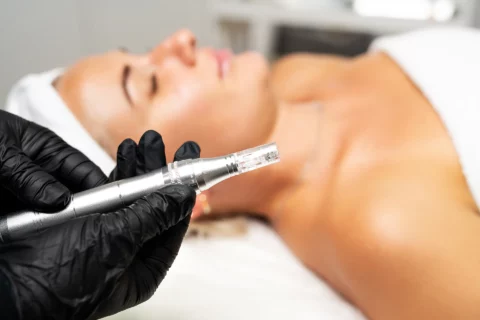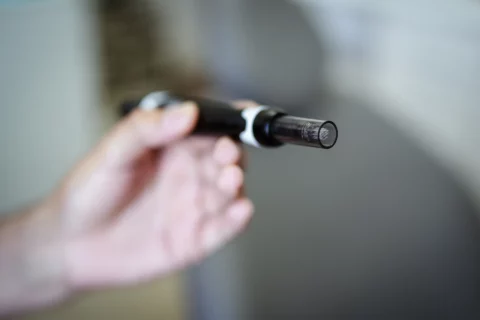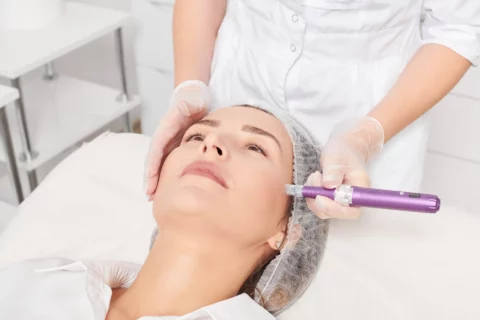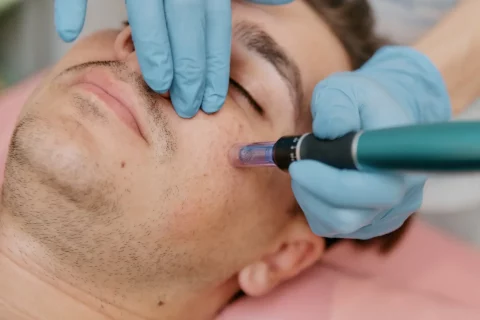Clinical-grade microneedling pens deliver precise depth control, consistent motor power, and medical-grade sterile cartridges to ensure professional treatment outcomes and patient safety. These essential features differentiate professional devices from consumer alternatives.
In the expanding world of aesthetic treatments, microneedling has emerged as a cornerstone procedure for skin rejuvenation. However, the market is flooded with devices claiming “clinical-grade” status without delivering professional-quality performance.
For aesthetic professionals seeking to provide safe, effective treatments, understanding what truly constitutes a clinical-grade microneedling pen is essential.
Introduction: Separating Fact from Fiction in Clinical Microneedling
The gleaming display cases at aesthetic conferences showcase dozens of microneedling pens, each promising superior results and claiming to be “clinical-grade.” Yet behind the sleek packaging and marketing language lies a spectrum of quality that can significantly impact treatment outcomes, patient safety, and practitioner liability.
True clinical-grade microneedling pens are sophisticated medical devices designed specifically for professional use, offering precise control, consistent performance, and adherence to stringent safety standards.
This article cuts through marketing claims to identify the essential features that define authentic clinical-grade microneedling pens, providing practitioners with the knowledge to make informed purchasing decisions.
Defining “Clinical-Grade”: More Than Just a Label
What Exactly Defines a “Clinical-Grade” Microneedling Pen?
Clinical-grade microneedling pens are purpose-built for professional aesthetic providers and medical practitioners. Unlike consumer devices, these pens are engineered to deliver consistent, precise skin penetration at variable depths with powerful motors that maintain performance throughout treatments. They incorporate medical-grade materials and construction standards that ensure reliability in professional settings.
Why is Using a Clinical-Grade Pen Important for Professional Treatments?
Professional-quality devices provide the control and consistency needed to achieve predictable results across different treatment areas and skin types. This precision minimizes risk while maximizing efficacy, making treatments safer and more effective. Additionally, using properly certified devices helps practitioners meet professional standards and insurance requirements, protecting both the practitioner’s practice and patients’ wellbeing.
How Do Clinical-Grade Pens Differ From At-Home Microneedling Devices?
The differences between professional and consumer devices are substantial:
| Aspect | Clinical-Grade Pens | At-Home Devices |
| Needle Penetration Depth | Ranges from 0.25mm to 3.0mm | Limited to shallower depths, usually up to 0.5mm maximum |
| Motor Power | Features powerful motors that maintain consistent needle speed regardless of skin resistance | Typically less powerful, with inconsistent speed on tougher areas |
| Control | Offers precision control over both needle depth and penetration speed | Limited or no control over needle depth and speed |
| Needle Cartridges | Accommodates medical-grade, single-use, sterile needle cartridges | May use reusable or non-sterile cartridges, increasing risk |
Essential Features to Look for in a Clinical-Grade Microneedling Pen

1. Precise Control
A true clinical-grade microneedling pen should offer precise depth control from approximately 0.25mm to 3.0mm, with incremental adjustments of 0.1mm or smaller. This range enables practitioners to:
- Use superficial depths (0.25-0.5mm) for sensitive areas like periorbital regions
- Apply medium depths (0.5-1.5mm) for general facial rejuvenation and product delivery
- Utilize deeper settings (1.5-3.0mm) for treating acne scars and stretch marks
Why is Precise Needle Depth Control a Key Feature in Professional Settings?
Precise depth control allows practitioners to customize treatments to specific skin concerns and anatomical regions. This precision prevents excessive trauma to delicate areas while ensuring adequate penetration in regions requiring more intensive treatment. The ability to make micro-adjustments enables practitioners to adapt treatments to individual patient needs, skin thickness, and tolerance levels.
How Does Adjustable Needle Speed Enhance Treatment Effectiveness and Comfort?
Variable speed settings (typically ranging from 6,000-14,000 RPM) allow practitioners to:
- Use slower speeds for sensitive areas, reducing discomfort
- Apply faster speeds for fibrous tissue like scars, increasing effectiveness
- Adjust penetration frequency based on treatment goals and patient comfort
- Create consistent micro-injuries regardless of how quickly the device is moved across the skin
2. Needle Quality and Safety
Clinical-grade needles should be manufactured from medical-grade stainless steel, specifically 316L surgical steel or similar medical-grade alloys. These materials offer:
- Superior sharpness that creates clean micro-channels without tearing
- Biocompatibility that minimizes risk of adverse reactions
- Resistance to bending or dulling during treatment
- Consistent performance throughout the procedure
Why is the Quality and Material of Needles Crucial for Safety and Results?
Low-quality needles can cause significant complications including:
- Uneven penetration resulting in inconsistent results
- Tearing or dragging that increases trauma and prolongs healing
- Bent needles that create larger, irregular punctures
- Metal fragments or micro-tears in the skin from manufacturing defects
Why are Single-Use, Sterile Needle Cartridges a Non-Negotiable Feature?
Single-use, sterile cartridges are essential for preventing cross-contamination and infection. Quality clinical devices feature:
- Individually sealed, sterile cartridges with verified expiration dates
- Safety mechanisms that prevent backflow of fluids into the device
- Easy-attach systems that maintain sterility during cartridge installation
- Clear verification that cartridges are properly secured before use
3. Power and Ergonomics
Wired pens offer consistent power without battery limitations, making them ideal for busy practices with back-to-back treatments. Wireless pens provide greater maneuverability and eliminate cord management issues, but practitioners should ensure they maintain consistent power throughout the battery cycle.
Is an Ergonomic Design Important for the User Experience and Treatment Precision?
Ergonomic design significantly impacts treatment quality by:
- Reducing practitioner hand fatigue during lengthy procedures
- Improving control and precision, especially in contoured facial areas
- Enabling comfortable handling from multiple angles
- Providing balanced weight distribution for steady application
What Role Does Motor Power and Consistency Play in the Performance of a Clinical-Grade Pen?
Motor quality is perhaps the most critical internal component, as it:
- Ensures consistent needle penetration regardless of skin thickness
- Prevents stalling when encountering firmer tissue like scars
- Maintains set speed throughout the entire battery cycle (for wireless devices)
- Provides reliable performance throughout the device’s lifespan
Additional Features to Consider
Treatment Versatility and Enhancement
Quality clinical devices offer compatibility with various needle configurations:
- Standard 9-12 pin configurations for general treatments
- Nano needle options for superficial product delivery
- Higher pin counts (36-42 pins) for larger treatment areas
- Specialized configurations for specific concerns like stretch marks
Should a Clinical-Grade Pen Have Different Treatment Settings?
Preset treatment modes can enhance efficiency and consistency by offering optimized settings for common concerns such as:
- Superficial rejuvenation
- Scar treatment
- Stretch mark reduction
- Product infusion protocols
Does the Microneedling Pen Offer Options for Enhancing Product Absorption?
Advanced clinical pens such as the Dr. Pen include features that facilitate transdermal delivery of therapeutic serums, such as:
- Specialized needle configurations designed for serum delivery
- Adjustable pulse patterns that enhance product absorption
- Compatibility with specific therapeutic solutions
User-Friendly Design and Support
Digital interfaces enhance precision and documentation by:
- Displaying exact treatment parameters
- Allowing for consistent replication of protocols
- Providing clear verification of settings
- Enabling easy adjustments during treatment
Comprehensive support for clinical devices typically includes:
- Initial hands-on training from qualified educators
- Protocol guides for various skin conditions
- Troubleshooting assistance and technical support
- Continuing education opportunities
Regulatory Compliance
Key certifications for clinical microneedling devices include:
- FDA clearance or registration for the specific intended use
- CE marking indicating compliance with European safety standards
- ISO 13485 certification for medical device manufacturing
- Documentation of biocompatibility testing for device materials
Conclusion

Selecting a true clinical-grade microneedling pen requires looking beyond marketing claims to evaluate the features that directly impact treatment safety and efficacy. By prioritizing precision depth control, high-quality needle cartridges, consistent motor performance, and proper regulatory clearances, practitioners can confidently select devices that will deliver reliable results.
A genuine clinical-grade microneedling pen represents an investment not only in your practice’s capabilities but in your patients’ outcomes and safety. With the knowledge to distinguish truly professional equipment from consumer-grade devices with professional packaging, aesthetic practitioners can elevate their microneedling treatments to deliver optimal results while maintaining the highest standards of care.






